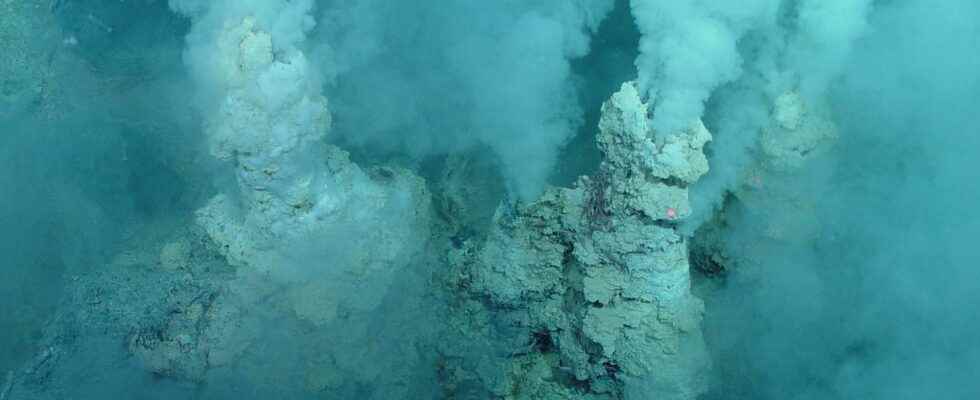Some hypotheses suggest that life appeared at the bottom of the oceans at hydrothermal vents. The bacteria currently observed there are based on methanogenesis, a process that releases energy if the environmental conditions are chemically favorable.
You will also be interested
[EN VIDÉO] What phenomena are at the origin of life? As early as 1871, Charles Darwin had imagined that terrestrial life could have been born “in a small pond”, from various chemical compounds which would have combined to form complex molecules. Another school of thought — panspermia — brought life from outer space. Today, the question is not resolved but scientists lean towards Darwin with a prebiotic chemistry.
Hydrothermal vents on the ocean floor, often referred to as black or white “smokers,” are known to harbor significant microbial life. True oases of life located several kilometers below the surface of the water, these vents provide heat, minerals and gas dissolved that allow many communities to microorganisms to develop oneself. These hydrothermal sites are moreover believed to be the cradle of life on Earth.
Methanogenesis for the synthesis of organic compounds
The conditions are however far from welcoming, by our standards, forcing micro-organisms to grow on the basis of chemical reactions quite different. Indeed, the organisms living in the oxygenated conditions which prevail on the surface develop by synthesizing the biomass, which is an energy-consuming processenergy. Conversely, the bacteria thermophiles living at hydrothermal vents synthesize their organic components from inorganic materials via the process of methanogenesis: carbon dioxide andhydrogen present in the water react to form methane and molecules of water. This reaction is called reducing and the formation of methane is accompanied here by a production of energy.
A new study is therefore interested in this process implemented in the depths of the ocean, at the level of hydrothermal vents. An important point in trying to resolve the crucial question of the origin of life on Earth. The researchers thus studied a field of hydrothermal vents named Rainbow, located on the mid-Atlantic ridge, as well as the site Endeavor located at the level of the Juan de Fuca ridge in the Pacific. The two study areas were chosen for their major difference in the composition of the oceanic crust on which they are positioned: Raindow, in the Atlantic, is characterized by a bedrock mainly composed of ultra-mafic rocks, such as peridotites serpentinized, while Endeavor in the Pacific rests on a basaltic bedrock (mafic rocks). At the level of these vents live communities of unicellular micro-organisms, in particular the Methanocaldococcus jannaschii. The researchers analyzed proteins and amino acids produced by these microorganisms through methanogenesis reactions at each of the two sites and compared the results.
Hydrothermal sites located on an ultra-mafic crust, more favorable to microbial development?
Their study, published in the journal Journal of Geophysical Research: Biogeosciences, shows that methanogenesis is linked to the presence of significant chemical imbalances that result from the mixing between hydrothermal fluids and seawater. interior of the oceanic crust. The proximity of the ridges inducing a strong gradient temperature, the fluids heat up on contact with the rocks, which promotes chemical exchanges with the surrounding rock. If the fluid, which is basically seawater, loses some chemical elements, it will also gain, to the point that its chemical composition when it leaves the vents will be very different from that of seawater. Its composition will also be largely dependent on the composition of the rocks it passes through. These fluids, loaded with minerals and dissolved gases, will react with the water as soon as they leave.
The team of scientists thus discovered that for hydrothermal systems resting on an ultra-mafic crust, as is the case of the Rainbow site in the Atlantic, the synthesis of proteins releases energy, and this for very varied temperatures of the hydrothermal fluid. Things are different at the Endeavor site, which is underlain by basalts. In this second case, the temperature range allowing methanogenesis by bacteria unicellular is clearly more reduced, and it appears that in this case, the synthesis of proteins by these micro-organisms does not release energy.
Certain types of hydrothermal systems therefore seem more favorable to microbial proliferation. This would be the case of ultra-mafic hydrothermal sites, whose chemical composition of the fluids generates already particularly reducing conditions. This specific chemical environment would allow the synthesis of proteins by methanogenesis in association with a strong release of energy. These results could provide a better understanding of the biogeochemical cycles involved in theemergence life at the bottom of the oceans.
Interested in what you just read?
